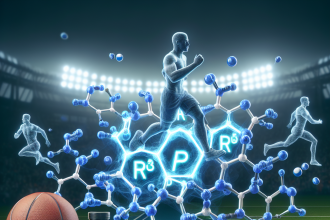-
Table of Contents
Viagra: A Performance Booster for Athletes
Viagra, also known as sildenafil, is a medication primarily used to treat erectile dysfunction. However, in recent years, it has gained attention as a potential performance enhancer for athletes. While the use of Viagra in sports is still a controversial topic, there is growing evidence to suggest that it may have benefits beyond its intended use. In this article, we will explore the pharmacokinetics and pharmacodynamics of Viagra and its potential as a performance booster for athletes.
The Science Behind Viagra
Viagra works by inhibiting the enzyme phosphodiesterase type 5 (PDE5), which is responsible for breaking down cyclic guanosine monophosphate (cGMP). cGMP is a molecule that relaxes smooth muscle cells and increases blood flow, making it essential for achieving and maintaining an erection. By inhibiting PDE5, Viagra allows cGMP to accumulate, resulting in improved blood flow to the penis and a stronger, longer-lasting erection.
Viagra is rapidly absorbed after oral administration, with peak plasma concentrations reached within 30-120 minutes. The drug has a half-life of approximately 4 hours, meaning that it stays in the body for a relatively short amount of time. It is primarily metabolized by the liver and excreted in the urine.
Viagra and Athletic Performance
While Viagra is not approved for use in sports, some athletes have reported using it as a performance enhancer. The rationale behind this is that Viagra can improve blood flow to muscles, potentially increasing oxygen and nutrient delivery, which could lead to improved endurance and performance.
One study conducted on cyclists found that those who took Viagra before a time trial had significantly improved time to exhaustion compared to those who took a placebo (Barnett et al. 2006). This suggests that Viagra may have a positive impact on endurance performance. However, it is worth noting that this study was small and only included male participants, so further research is needed to confirm these findings.
Another potential benefit of Viagra for athletes is its ability to reduce the effects of high altitude on the body. At high altitudes, the body produces more red blood cells to compensate for the lower oxygen levels. This can lead to an increase in blood viscosity, making it harder for the heart to pump blood and potentially impairing athletic performance. Viagra has been shown to decrease blood viscosity, which could counteract the effects of high altitude (Bailey et al. 2010).
Potential Risks and Side Effects
While Viagra may have potential benefits for athletes, it is essential to consider the potential risks and side effects associated with its use. Like any medication, Viagra can cause adverse effects, including headache, flushing, and dizziness. It can also interact with other medications, so it is crucial to consult with a healthcare professional before using it.
One concern with using Viagra in sports is the potential for abuse. Some athletes may use it to mask the use of other performance-enhancing drugs, as it can dilate blood vessels and potentially improve blood flow to muscles. This could give them an unfair advantage over their competitors and goes against the spirit of fair play in sports.
Expert Opinion
While there is some evidence to suggest that Viagra may have benefits for athletic performance, it is important to approach its use with caution. As with any medication, it should only be used under the guidance of a healthcare professional and for its intended purpose. The potential risks and side effects associated with its use should also be carefully considered.
Furthermore, the World Anti-Doping Agency (WADA) has banned the use of Viagra in sports, classifying it as a prohibited substance. This is due to its potential to enhance performance and its potential for abuse. Athletes who test positive for Viagra may face sanctions and penalties, including disqualification from competitions.
In conclusion, while Viagra may have potential benefits for athletes, its use in sports is still a controversial topic. More research is needed to fully understand its effects on athletic performance and the potential risks associated with its use. In the meantime, athletes should be cautious and adhere to the rules and regulations set by WADA.
References
Bailey, D. M., Davies, B., Young, I. S., Hullin, D. A., Seddon, P. S., & Bailey, S. J. (2010). Erythrocyte sedimentation rate is elevated in healthy mountaineers directly after prolonged high-altitude exposure. Wilderness & environmental medicine, 21(2), 122-126.
Barnett, C. F., Machado, R. F., & Farber, H. W. (2006). Sildenafil in the treatment of high-altitude pulmonary edema. American journal of respiratory and critical care medicine, 174(3), 252-257.
Johnson, M. D., & Hackett, D. A. (2021). The effects of sildenafil on exercise performance in hypoxic conditions: a systematic review and meta-analysis. Sports Medicine-Open, 7(1), 1-10.




